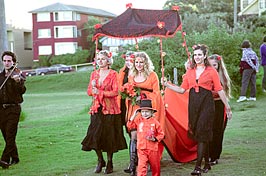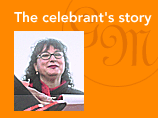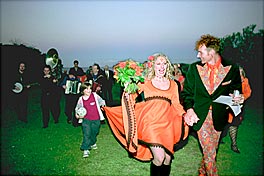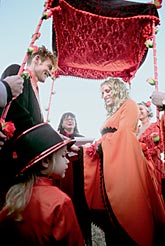
Rachel & Neill |
Rachel & NeillAuthor: Megan Wynne-Jones, Getting Married project
Getting Married: On the edge of a cliff, under the traditional Jewish hoopa, the couple, dressed in orange, receive the seven blessings of a Jewish wedding. They are accompanied by a gypsy band to the nearby bowling club for the hora circle dance and an orange cake...
A Jewish wedding with a twist On the clifftop Finally the bride is here, delayed by the orange taxi which had been ordered but never arrived. The gypsy band -– tuba, accordion, violin and singer – begins to play. Dressed in a short orange frock with a long orange train, and wearing long black patent leather boots, Rachel begins her walk to the clifftop. Her four year old son from a previous marriage, Ruben, also dressed in orange, is with her. Four bridesmaids, clad in black with orange trimmings, hold over her the four poles of the orange hoopa or marriage canopy, whilst a fifth carries her train. When the bridal party has reached the clifftop and Neill has joined Rachel under the hoopa, Nitza Lowenstein, the Jewish civil celebrant, introduces herself and welcomes everyone to the wedding. Rachel's two brothers, dressed in orange and wearing long black wigs, read Rumi's poem, “The Privileged Lovers”. The moon has become a dancer at this festival of love. Under the hoopa - the vows and the rings With Neill and Rachel under the hoopa, one of the bridesmaids reads another Rumi poem: My arrow of love has arrived at the target.  The bride arrives Now Neill and Rachel hold hands. They make their pledges – for richer for poorer, for better for worse, in sickness and in health, to love, cherish and respect. For the exchange of rings, they have written their own vows, reflecting the deep emotional commitment at the heart of their relationship. Neill begins.
Rachel follows with words she has especially composed for Neill.
In a moving moment, the couple also give Rachel's son Ruben a ring, to symbolise his inclusion in their marriage. The rings they have chosen are spiral shaped, to represent the fern leaf or koru in Maori, which according to Neill is a symbol of new life, growth, the eternal, the feminine. The wine and the blessings Next, in a vital element of the Jewish wedding, Nitza reads the traditional seven blessings in Hebrew. The blessings celebrate the bond of love, the power that joins the couple, expressing gratitude for their happiness and union. Rachel's mother provides the English translation. “…May all the world soon ring out with the sounds of happiness, the voices of lovers in joyous celebration….”. The breaking of the glasses, the wedding concludes Neill and Rachel, in their orange and black footwear, stamp on the two glasses, which are wrapped in cloth. The relatives and friends shout “mazeltov!” which means good luck. The music starts up, orange rice is thrown over the couple, Nitza announces
them as husband and wife, and they sign the marriage papers. A final blessing
is made by Nitza: “We pray that they grow old together in health, happiness,
success and contentment and forever grateful for their lives.” Getting together How it started…
And so began their relationship. Neill was the saxophonist with a New Zealand band who had been hired to play in Sydney at a bat mitzvah, a Jewish coming of age ritual and celebration for girls. They spotted each other on the dance floor and by the end of the night had started talking. Over the next few days their romance blossomed, and Rachel had a strong “gut knowingness” that they had a future together. Neill had to go back to New Zealand, but made plans to return. Their relationship continued at a distance, sustained by emails, letters and phone calls. Six months later, Neill left New Zealand permanently and moved into Rachel's Bondi flat where she was living with her son. Why marriage?
For Rachel, marriage the second time round feels very different. She is more nervous and ambivalent about going through with her second wedding.
For her the “well thought out decision” of an arranged marriage might offer more comfort and understanding than one based on emotion. But her bottom line is that feelings are what count.
As well as a public commitment, their wedding is also an opportunity to take part in a meaningful ritual. They are both performers with a deep love of ritual and ceremony of any kind. The proposal Leaping off They both wanted a Jewish celebrant and the elements of a Jewish wedding. To this they have added rituals and symbols from other cultures that have important meaning for them, and have chosen vibrant colours and music that reflect their style. They wanted the ceremony to take place near the sea and chose the clifftop at Clovelly in the eastern suburbs of Sydney as the site.
The reception party Inside, everything is orange. There are streamers, bows, flowers, napkins, cutlery, candles and a huge orange floral heart with a centerpiece photograph of the couple. The food, which has been provided by the guests, is laid out in the centre of the room. A traditional Jewish wedding would also include a special plaited bread called halla served at the reception. After dinner the speeches begin with a moving one from Rachel's grandmother, a Polish Jew and survivor of the concentration camps. Her marriage took place in a refugee camp after the war, and lasted 55 years, until the death of her husband. “Life experience is a very good teacher – it depends how we take it. We always think that someone's grass is greener and are never satisfied with our own. So Neill and Rachel, be grateful for what you have now and may God bless you with good health, love, joy and fulfillment… I wish you a very long and fruitful marriage. I love you both very much.” Rachel's father also speaks, as do Neill and Rachel. Neill's sister speaks first in English and then in Maori.  Nitza, the Jewish marriage celebrant Then the dancing begins. All the guests join in the circle dance called the hora and sing hava na gila – “let's rejoice”. The music and dancing gets wilder and suddenly Rachel and Neill are lifted up on separate chairs and held high above the heads of the crowd and thrown around. Out comes the wedding cake, in black and orange, and while the guests eat, the night's entertainment begins. Neill's band provides most of the music, while a juggler, rap singer, and talking mechanical dog keep the guests amused until the early hours of the morning. A wedding quite unlike any other. Life together with a new arrival After a brief honeymoon in Sydney, the couple began their married life together. In the spirit of adventure and surprise to which they both aspire for their relationship, not long after their wedding Rachel became pregnant. Their baby girl, Nina Rose, was born on March 10, 2003. > Take a look at some more weddings |
||||||||||||||||||||||||||||||||||||||||||||


